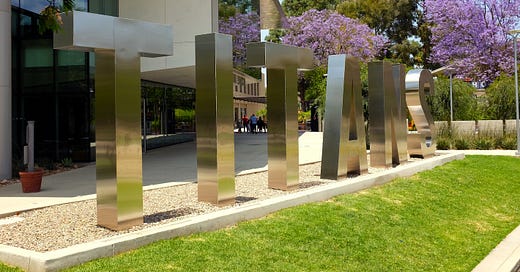Major Accreditor Reconsiders DEI Requirements
Letters to universities show how the requirements have been implemented.

A win for open inquiry has appeared amidst relentless uncertainty in higher education. The Western Association of Senior College and University Commission (WSCUC), the accreditor of most universities in California and Hawaii, is reconsidering the diversity, equity, and inclusion (DEI) requirements for accreditation in light of the Trump Administration’s executive order on accreditation.
Among other things, the executive order — the legality of which has not yet been established — bans accreditors from requiring universities to adhere to DEI standards as a part of the accreditation and re-accreditation processes. Though the total banning of all things “DEI” represents another political intrusion on academic freedom, dropping DEI as an accreditation requirement allows more space for freedom of thought in higher education as institutions are no longer bound to a particular partisan orthodoxy.
Departure from DEI requirements would be a significant change for WSCUC (though obviously carried out under duress). Their 2023 Standards of Accreditation — which all universities seeking WSCUC accreditation must adhere to — elevate DEI as a core tenet. Each of the four overarching WSCUC 2023 standards begins with a preamble requiring that any university seeking accreditation or re-accreditation “makes explicit its commitment to diversity, equity, and inclusion” and expects that institutional purposes be imbued with commitments to DEI. WSCUC itself has integrated equity and inclusion into its own organizational strategic goals and objectives and presently maintains an Equity & Inclusion Council.
A review of available materials by HxA’s research team shows WSCUC has reprimanded universities found to be insufficient in their zeal for DEI and instructed them to address WSCUC concerns that are typically later reviewed in a follow-up visit. For example, in 2018, WSCUC suggested that San Jose State University “deepen the effort to recruit, hire, and retain faculty who reflect the diversity of the SJSU student community.” SJSU’s records indicate that the share of white faculty decreased rather considerably after that, from about 55% in 2018 to 37% in 2025.
Similarly, in 2020, California State Fullerton received word that it should “continue to focus on faculty diversity with special attention to units that have made less progress than others.” Since Fall 2020, the share of white faculty at Cal State Fullerton decreased somewhat, from 58% to 51%. It is impossible to say exactly what influence WSCUC had on hiring decisions, given other potential external and internal demands on university hiring, particularly following the racial unrest of 2020. But it cannot be ruled out that among the myriad of factors influencing faculty hiring, WSCUC expectations ranked among them.
In 2021, WSCUC recommended to California Lutheran University that they strengthen “resources dedicated to recruiting, supporting, mentoring, advising, and retaining faculty of color” and begin to “measure the execution of a diversity-enhanced curriculum.” Shortly thereafter, California Lutheran hired their first Chief Diversity Officer, and the student newspaper’s story on the hire referenced the accreditor. In a follow-up visit, WSCUC praised California Lutheran for their DEI efforts.
And, last year, Azusa Pacific University was told to “implement the University’s diversity, equity, and inclusion strategic plan” although the university student body was 74% non-white, suggesting that it was already a vibrant and welcoming community to historically underrepresented populations.
WSCUC recommendations don’t always result in real-world actions. In 2018, Humboldt State University was told to “prioritize diversification of faculty and staff demographics… to align with the diversity of the student body” but records indicate that the share of non-white faculty has not changed significantly since then.
Adherence to the DEI standards can result in positive recognition by the accrediting body. For example, in the same letter to SJSU as cited above, WSCUC praised that institution for its newly established Office of Diversity, Equity, and Inclusion. Whittier College was commended for a strong commitment to DEI, “as evidenced by… restorative justice conversations.”
As this sampling of many cases illustrates, far from being mere rubber stampers, accrediting agencies and their policies wield tremendous influence over the world of higher education. The bureaucratic tedium of accreditation belies the power of any given accreditor to influence university policy for enormous numbers of institutions, students, and faculty. The Californian and Hawaiian universities under WSCUC’s specific purview host over 12% of the university students in the U.S. and are the academic homes for thousands of faculty. By pumping the brakes on their DEI policy, WSCUC is loosening the grip that DEI orthodoxy — especially in regards to hiring practices — has on WSCUC-accredited institutions.
Although WSCUC has only paused the enforcement of their DEI-related standards while the standards are reviewed, an abandonment of DEI requirements for accreditation seems inevitable given the actions of the Trump Administration. This welcome potential depoliticization of accreditation would hopefully be considered by other major institutional accrediting bodies.
It’s worth noting that of the major accreditors, WSCUC and its community college equivalent organization, the Accrediting Commission for Community and Junior Colleges (ACCJC), have demonstrated a particular fervor for DEI. For example, ACCJC’s Policy on Social Justice boasts that ACCJC’s “current commitment to promote equity, diversity, and foster inclusionary practices is rooted in its understanding of historical and systemic institutional racist structures and policies that exist in society, stemming from prejudice, discrimination, and implicit biases, which have benefited white people and disadvantaged people of color.”
And it may be turtles all the way (up and) down, given that the Council for Higher Education Accreditation, which essentially accredits the accreditors and oversees WSCUC, “affirms that diversity, equity, and inclusion are inextricably connected to quality assurance in higher education.”
Still, if WSCUC’s change of course is any indication, there is reason to hope that other accrediting bodies will follow suit and re-align themselves with their missions to promote quality education rather than restrictive, politicized dogmas.





